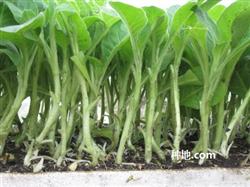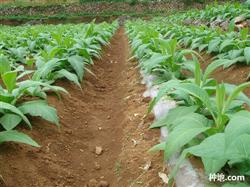How to control tobacco wildfire disease and angular spot disease?

How to prevent and cure tobacco wildfire and corner spot? Tobacco wildfire disease and angular spot disease are important diseases in tobacco. The two diseases are similar in the characteristics of pathogens, infection rules and control methods. These two kinds of bacterial diseases often occur in the field, and are more common in all tobacco areas in the country. Wildfire disease occurred more seriously in Heilongjiang, Liaoning, Shandong, Yunnan, Sichuan, Shaanxi and other provinces, while angular spot disease was more serious in Shandong, Fujian, Henan, Guizhou, Jilin and Yunnan. The following is a brief introduction to the occurrence and control of these two bacterial diseases. First, occurrence characteristics: wildfire disease mainly occurs in the later stage of tobacco plant growth. Sometimes it happens at the seedling stage. When the leaves are damaged, they first produce small round spots like brown water stains, surrounded by a wide yellow halo. When the lesion is enlarged, it merges into a large irregular spot with a wheel pattern. The disease can form a thin layer of bacteria when the weather is humid. After drying, the disease spot breaks and falls off, and the leaves are destroyed. The incidence of wildfire disease in field tobacco plants in Yunnan generally began from late June to early July, and then the disease increased rapidly, and the first epidemic peak appeared in the middle of July. The disease decreased in late July, and the second peak appeared in the first ten days of August, which was lower than that in the first peak. In the middle of August, the disease decreased slowly and spread slowly until the top leaf of tobacco plant matured. Under the condition of heavy rain in late August, the disease in the field will rise rapidly, resulting in damage to the upper leaves of tobacco plants. The disease of angular spot was more serious in the later stage of tobacco plant growth. The angular black-brown spots formed on the diseased leaves have obvious edges and no obvious yellow halo around them. When the disease of adult leaves is serious, the disease spot is polygonal or irregular, dark brown or dark brown at the edge, grayish brown or dirty white in the center, and often appears heavy cloud-shaped wheel pattern and arm-shaped when developing along the leaf vein. The epidemic pattern of angular spot disease is similar to that of wildfire disease. Second, disease conditions: tobacco wildfire and angular spot pathogens can survive near the roots of many crops and weeds in addition to overwintering on seeds and diseased plant residues. Germs are spread by wind, rain and insects. The pathogen invades through the stomata of the leaves. When the leaves are moist, water in the stomata is easy to invade. Water is limited and bacteria can only form a black dot on the leaf. Water filling in leaves is most beneficial to the growth of bacteria. The air and soil humidity is high, especially after the storm. Excessive application of nitrogen fertilizer, lack of potassium fertilizer, tobacco plant growth in the later stage is too prosperous, susceptible to disease. 3. Prevention and control methods: as there are no ideal disease-resistant and high-quality varieties at present, the method of "prevention first and comprehensive control" is adopted in prevention and control. The disease of continuous cropping is more serious than that of rotation. Destroying the disease and residue in tobacco field and reducing the source of infection can effectively reduce the harm. Proper use of nitrogen fertilizer, pay attention to the application of phosphorus and potassium fertilizer, improve the disease resistance of tobacco plants. Timely removal of susceptible foot leaves to improve field microclimatic conditions and reduce the harm of bacterial infection. Before and after topping, tobacco was sprayed with Bordeaux solution or 200 units / ml of agricultural streptomycin, once every 7-10 days, 2-3 times in succession. Click to get more tobacco planting techniques click to get more flower planting techniques
- Prev

How to raise seedlings and how to manage tobacco?
How to raise seedlings and how to manage tobacco? Seedling transplanting is a tobacco cultivation method widely used all over the world. In the cultivation of tobacco in China, except for a small number of yellow flower tobacco and sun-cured tobacco, the vast number of tobacco areas are seedlings and transplanting. The basic requirement of raising seedlings is to produce strong seedlings with sufficient quantity and suitable size in time. General requirements for spring smoke.
- Next

What situations should be prevented from growing tobacco?
What situations should be prevented from growing tobacco? Early flowering is the phenomenon that tobacco plants bloom ahead of time because they do not reach the height and number of leaves that the varieties should have grown normally. The root cause of early flowering is that the growth of tobacco plant is blocked and develops too fast. The factors leading to early flowering are dry climate, especially lack of water in prosperous period, early transplanting, long-term low temperature or.
Related
- Fuxing push coffee new agricultural production and marketing class: lack of small-scale processing plants
- Jujube rice field leisure farm deep ploughing Yilan for five years to create a space for organic food and play
- Nongyu Farm-A trial of organic papaya for brave women with advanced technology
- Four points for attention in the prevention and control of diseases and insect pests of edible fungi
- How to add nutrient solution to Edible Fungi
- Is there any good way to control edible fungus mites?
- Open Inoculation Technology of Edible Fungi
- Is there any clever way to use fertilizer for edible fungus in winter?
- What agents are used to kill the pathogens of edible fungi in the mushroom shed?
- Rapid drying of Edible Fungi

